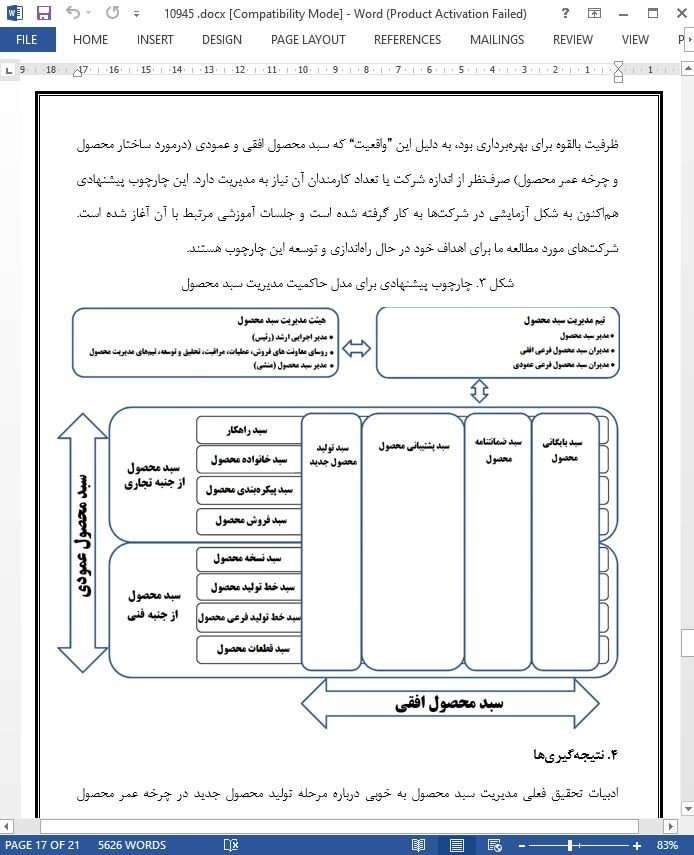
مدیریت سبد محصول – حاکمیت مدیریت سبد تجاری و فنی محصول در طول چرخه عمر محصول
چکیده
شرکتها با یک پرسش مهم روبرو هستند که آیا باید اجازه دهند نوسازی سبد محصول بدون هیچ مداخلهای و صرفا با افزودن محصولات جدید صورت پذیرد یا این نوسازی باید مبتنی بر اهداف راهبردی و مالی در چرخه عمر محصول باشد؟ مباحث مربوط به مرحله تولید محصول جدید به خوبی در قالب مدیریت سبد محصول تجزیه و تحلیل میشوند، اما مراحل بعدی چرخه عمر آتی محصول در ادبیات تحقیق این موضوع به خوبی تشریح نمیگردند. سطوح مختلف ساختار محصول هم به اندازه کافی به حساب نمیآیند و درعوض مدیریت سبد محصول کنونی فقط به طور کلی درباره”محصول“ صحبت میکند. بنابراین، انگیزه انجام این مطالعه موردیِ چندگانه با رویکرد اکتشافی، بررسی و تحلیل چالشهای عملی مرتبط با سبد محصول در 10 شرکت مورد مطالعه و مشخص شدن ناکارآمدیهای نظریه مدیریت سبد محصول فعلی بوده است. نتایج اصلی این مطالعه شامل مشخص شدن نیاز به یک مدل جدید حاکمیت مدیریت سبد محصول است که مدیریت سبد فنی و تجاری محصول را در مراحل چرخه عمر ممکن نماید. در این مطالعه، یک چارچوب مدل حاکمیت بر مبنای سبدهای محصول افقی و عمودی پیشنهاد شده است که توسط دو تیم متمرکز مدیریت میشوند. بر مبنای دادههای مطالعه و دیدگاههای کارشناسان صنعتی، مدل جدید حاکمیت مدیریت سبد محصول پیشنهاد شده دارای ظرفیت کمک به مدیران تجاری است برای شناخت مدیریت سبد محصول به عنوان مفهومی که در مدیریت و نوسازی سبدهای محصول موجود ایفای نقش مینماید. این مدل جدید پیشنهادی جنبههای تجاری و فنی سبد محصول را در تمامی مراحل چرخه عمر و در همه سطوح سازمانی نظیر همکاری تیمهای تجاری و مهندسی شامل میشود.
1. مقدمه
تمرکز بر تحقق نیازمندهای کوتاهمدت مشتریان در 20 سال اخیر موجب پدید آمدن تعداد بسیار زیادی از انواع تدریجی محصولات و پروژههای تولید محصول جدید شده است. نتیجه اینکه، در طول مدت یاد شده تعداد کمتری از محصولات کاملا جدید و نوآورانه تولید شده است [1]. متنوع کردن سبد محصول یکی از راههای افزایش فروش و برآورده کردن نیاز مشتریان در نظر گرفته میشود [2]-[4]، روندی پیشرو که در آن تعداد محصولاتی که عرضه میشوند از تعداد محصولاتی که منسوخ میشوند بیشتر است. بعنوان مثال، طبق نظر [5] به ازای هر محصولی که از رده خارج شده است، 1.8 محصول جدید به سبد محصولات افزوده شده است. موضوعات یاد شده عوامل بالقوه برای بسیاری از چالشهای مدیریت سبد محصول در صنعت هستند. دامنه بیش از حد وسیع محصولات میتواند به گیج شدن مشتریان و متعاقباً تضعیف فروش کل و همچنین کاهش میزان فروش هر محصول منجر گردد ([2][6]-[8]). علاوه بر این، عرضه غيرضرورى محصولات متنوع به پیچیدگی آنها خواهد انجامید، تأثیرات منفی بر بهرهوری، زمان تولید محصول، و هزینههای زنجیره تامین خواهد داشت [9]-[11]. ادغام و تصاحب از طریق خرید همزمان میتواند موجب رشد تصاعدی سبد محصولات شرکت شود یا حتی آن را به حد انفجار برساند، مثلا [12]. یکی از چالشهای اساسی در مدیریت سبد محصول، فقدان علاقه و شناخت کافی از مفهوم مدیریت سبد محصول در سطوح مختلف مدیریت ارشد سازمان است.
4. نتیجهگیریها
ادبیات تحقیق فعلی مدیریت سبد محصول به خوبی درباره مرحله تولید محصول جدید در چرخه عمر محصول توضیح داده است که شامل اهداف و شاخصهای کلیدی عملکرد، فرآیندها، و ابزارهای مدیریت سبد محصول مربوطه میشود. به نظر میرسد که مسئولیت تصمیمگیریها در مدیریت سبد محصول با تیمهای چندتخصصه در سطح مدیران اجرایی است. درحالیکه در ادبیات تحقیق فعلی از حاکمیت مدیریت سبد محصول درباره چگونگی مدیریت سبد محصول چه به صورت عمودی در مورد سطح ساختاری محصول و چه به صورت افقی در مورد تمامی مراحل چرخه عمر محصول هیچ تعریف عملی ارائه نشده است.
Abstract
Companies face an important question on whether they should allow product portfolio renewal to occur without interference by merely adding new products, or should the renewal be governed based on strategic and financial targets over life cycle? New product development phase is well covered in the product portfolio management (PPM) context, but later product life cycle phases are not covered well in this context. Neither are the different product structure levels adequately taken into account, instead the current PPM only discusses the “product” in general terms. Based on analysing the portfolio related practical challenges in ten case companies, and realising the deficiencies of current PPM theory motivated this explorative multiple case study. The principal results of this study involve revealing the need for a new potential PPM governance model that enables managing commercial and technical product portfolios over life cycle phases. A governance model framework, based on horizontal and vertical portfolios managed by two centralised teams, is proposed. Based on the data, and views of industrial experts, the created new PPM governance model has potential to aid business managers in understanding PPM as an entity that has a role in managing existing product portfolios and their renewal based on commercial and technical portfolios over life cycle as collaboration between business and engineering teams in all organisational levels.
1. Introduction
Focus on fulfilling short term customer requirements over the past 20 years has resulted in vast amounts of incremental type of new products and product development projects. As a consequence, less pure new products, completely new product innovations to the world have been created [1]. A diverse product portfolio is seen as a way to increase sales and to fulfil customers’ requirements [2]-[4], a leading trend where more products are introduced than removed. For example, according to [5] for each removed product, 1.8 new ones are added to the portfolio. These above described issues are potential drivers for many product portfolio management (PPM) challenges in industry. Overly broad product range can lead to mass confusion by the customers, thus weakening overall sales and the sales per product ([2] [6]-[8]). Also, unnecessarily broad product offering leads to product complexity, negatively impacting productivity, product development time and demand supply chain costs [9]- [11]. Company’s product portfolio may expand or even explode rapidly due to simultaneous company mergers and acquisitions, e.g. [12]. A fundamental challenge in PPM is the lack of interest and understanding about the PPM concept by different teams of senior management.
4. Conclusions
The current literature on PPM covers well the NPD phase of the product life cycle including related product portfolio management targets and KPIs, processes and tools. PPM decisions are seen as the responsibility of executive level cross functional teams. However, there are no practical descriptions of the PPM governance on how to manage the product portfolio both vertically over product structure levels and horizontally over all life cycle phases.

چکیده
1. مقدمه
2. روششناسی
3. نتایج
3.1 مطالعات موری
3.2 چارچوب پیشنهادی
4. نتیجهگیریها
Abstract
1. Introduction
2. Method
3. Results
3.1. The Case Studies
3.2. The Proposed Framework
4. Conclusions
- اصل مقاله انگلیسی با فرمت ورد (word) با قابلیت ویرایش
- ترجمه فارسی مقاله با فرمت ورد (word) با قابلیت ویرایش، بدون آرم سایت ای ترجمه
- ترجمه فارسی مقاله با فرمت pdf، بدون آرم سایت ای ترجمه
